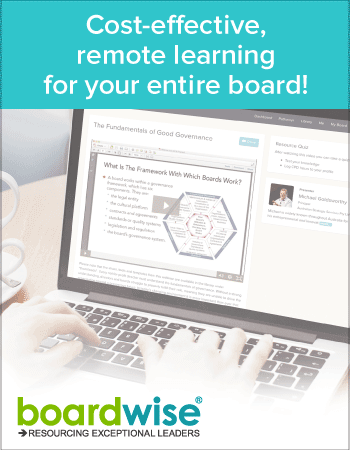glossary
Meeting Agenda
Governance GlossaryPublished: March 9, 2023

A meeting agenda is a document that provides a high level outline of the topics that are going to be discussed at a specific meeting. Ideally the Agenda is prepared and distributed in advance of the meeting to ensure that all attendees are able to come to the meeting prepared and aware of the topics that will be discussed. The agenda provides a roadmap for the meeting, helping to keep the discussion on track and ensuring that all important topics are covered.
What to include on your meeting agenda
An effective meeting agenda should include the following elements:
Meeting purpose:
The agenda should clearly state the purpose of the meeting, including the overall goal or objectives that the meeting aims to achieve. This helps attendees understand the significance of the meeting and the topics that will be discussed.
Date, time, and location
The agenda should include the date, time, and location of the meeting, so that attendees can plan accordingly.
Attendees
The agenda should include a list of attendees, including any required or invited guests.
Agenda items
The agenda should list all of the topics or items that will be discussed during the meeting, in the order in which they will be discussed. Each agenda item should include a brief summary or description of the topic, as well as the name of the person who will be leading the discussion.
Time allocations
The agenda should include an estimate of the amount of time that will be allocated for each agenda item. This helps attendees understand how much time they need to prepare for each topic, and also helps to keep the meeting on track by ensuring that discussions don’t run over time.
Materials and logistics
The agenda should include any materials or logistics that attendees will need to bring or be aware of, such as handouts or equipment that will be used during the meeting.
Follow-up
The agenda should include details of any follow-up actions or decisions that will be made after the meeting, as well as any deadlines for these actions.
An effective meeting agenda
An effective meeting agenda helps to ensure that a meeting is productive and efficient. It helps to keep discussions on track and ensures that all important topics are covered. Additionally, an effective agenda can help to reduce confusion and misunderstandings among attendees, by providing a clear and concise overview of the topics that will be discussed.
However, it is important to keep in mind that a meeting agenda is only a guide, and that discussions may diverge from the agenda as new information or ideas arise during the meeting. Attendees should be encouraged to speak up if they feel that a topic is not being covered adequately or if they have new information or ideas to share.
Additionally, the meeting agenda could be distributed in various forms such as a hard-copy or an electronic version, and many modern tools like the Our Cat Herder board portal allow you to attach an agenda as a file or build it within the platform.
A meeting agenda is a critical tool for effectively planning and conducting meetings. It helps to keep discussions on track, ensures that all important topics are covered, and helps to reduce confusion and misunderstandings among attendees. By including all the relevant information and allocating time for each agenda item, a good meeting agenda can ensure that a meeting is productive and efficient.
Strategic Board Meeting Agenda
Increasingly popular with many boards the Consent Agenda or Strategic Board Meeting Agenda is a tool that can give your meetings a more strategic focus.
The core idea is to streamline each meeting by removing the usage of Roberts Rules of Order from the agenda structure and instead collecting all items that are for noting only (routine, non-controversial items such as reports, appointments or routine correspondence) into a group where all are passed with a single motion and vote, thereby freeing up more time in the meeting for decision making. Thus converting meetings from a reporting session to a strategically focused decision making session.
Resources
The Importance of Getting Your Agendas and Minutes Right
Your Guide to More Effective Board Meetings
How Well Is Your Board Managing its Scarcest Resource?
How to run remote board meetings securely and effectively
Meeting Minutes, An Essential Guide for Directors
What are 5 things you would include in a meeting agenda?
- A clear and specific agenda, stating the purpose and desired outcome of the meeting.
- A list of attendees and any materials or documents that they should bring or review before the meeting.
- A schedule for the meeting, including allocated time for each agenda item and any breaks.
- Details of any remote participants, such as phone numbers or video conferencing information.
- Any necessary background information or context for the agenda items to ensure that all attendees are fully informed and prepared to discuss the topics at hand.
What are 3 types of agendas?
There are many types of agendas that can be used for meetings, but the three common types are:
- Informational agenda: This type of agenda is used to provide updates and information to the attendees, rather than to make decisions or take action. The focus is on sharing information and keeping the attendees informed about the latest developments.
- Decision-making agenda: This type of agenda is used to make decisions or take action on specific issues. The focus is on gathering information, discussing options, and reaching a conclusion or making a decision.
- Combination agenda: This type of agenda is a combination of informational and decision-making, it includes the provision of information, and also includes a segment of the meeting to make decisions or take action. It could also include a team-building or problem-solving activities.
Recommended Reading
Recommended Viewing
Author
- About
-
Better Boards connects the leaders of Australasian non-profit organisations to the knowledge and networks necessary to grow and develop their leadership skills and build a strong governance framework for their organisation.
Found this article useful or informative?
Join 5,000+ not-for-profit & for-purpose directors receiving the latest insights on governance and leadership.
Receive a free e-book on improving your board decisions when you subscribe.
Unsubscribe anytime. We care about your privacy - read our Privacy Policy .










